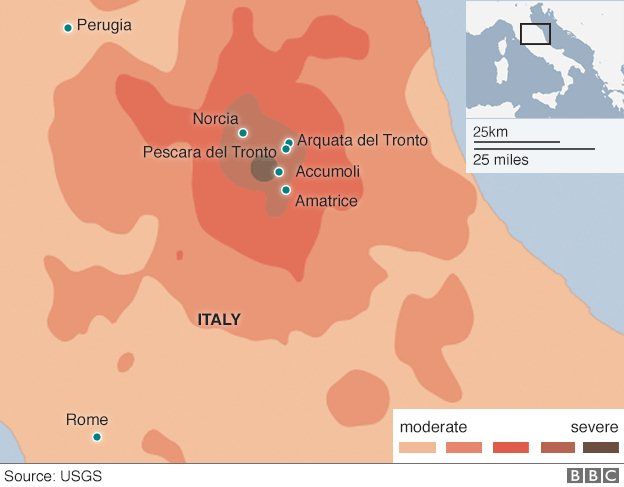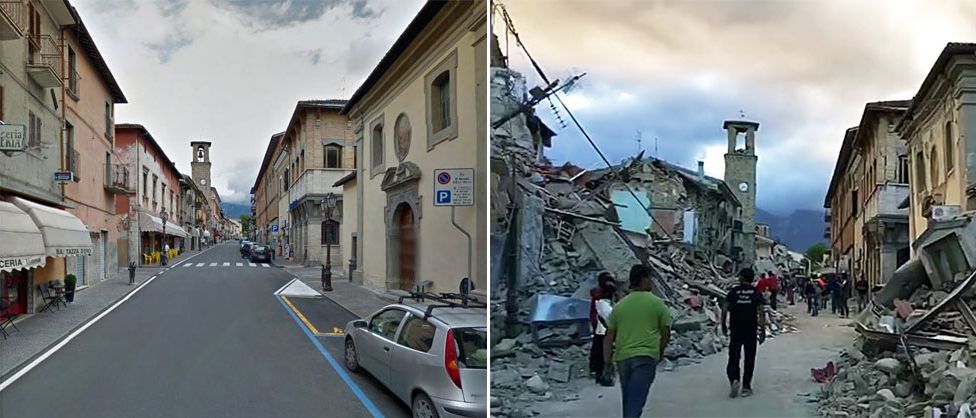 |
| USGS map of Central Italy Earthquake |
Amatrice, a historical town that had recently been filled with tourists, was almost completely flattened. The quake triggered a succession of aftershocks, causing more damage and deep fear in the population (European-Mediterranean Seismological Centre, 2016). Stone buildings that had stood for centuries crumbled in seconds. These structures were not equipped to withstand seismic shaking, and landslides in the mountainous terrain further isolated the region, complicating rescue efforts as debris blocked key access routes (BBC News, 2016).
 |
| Before and After Photos of Amatrice |
Nearly 300 lives were lost, and many of those who survived were left trapped beneath the rubble of collapsed buildings. The earthquake injured hundreds and displaced thousands, as entire communities were forced to abandon homes that had stood for generations (Reuters, 2016). While Italian emergency services worked to locate and rescue survivors, but the sheer magnitude of the destruction left many in shock.
The economic damage was extensive, as entire towns needed to be rebuilt, and the loss of cultural heritage was incalculable, estimated to be approximately €5 billion in damage (Di Bucci & Dolce, 2021.) Amatrice, known for its medieval architecture, had buildings that had withstood centuries of change. This left the infrastructure highly vulnerable to collapse during the earthquake. Economic reliance on agriculture and tourism intensified the disaster’s socioeconomic repercussions, as both had suffered heavily from structural damage. (Di Bucci & Dolce, 2021). The earthquake revealed the vulnerability of Italy's aging infrastructure, highlighting how devastating being unprepared for seismic activity can be (U.S. Geological Survey, 2016; BBC News, 2016).
This earthquake really emphasizes the debate around balancing the preservation of cultural heritage with the urgent need for earthquake-proof infrastructure, especially in a country has such a deep and expansive history as Italy does. Many older buildings are cultural landmarks standing for hundreds of years, which makes them highly vulnerable to collapse when earthquakes strike. For Italy, finding the balance between preserving history and protecting lives has become a crucial issue, one that is especially relevant as the country sits on multiple fault lines.
| Summary of the results of the damage and usability inspections on public and strategic buildings and structures |
Di Bucci and Dolce, when researching and preparing a case study regarding this disaster, highlighted the importance of retrofitting existing buildings to meet modern standards, as many structures in Italy are hundreds of years old and unable to resist large earthquakes. The study conducted shows that at least 50% of public buildings-which did not include schools as that was a separate inspection that 34% were unsafe for return-were considered unsafe after inspections were carried out once the main shocks had ceased. (Di Bucci & Dolce, 2021) Improved coordination between local and national authorities in response efforts would be a benefit as well, since rescue operations were hampered by poor access and delayed communication. Thankfully, there was a total of 769 million euros invested into rehabilitating the road after the damages.(Di Bucci & Dolce, 2021) Considering the inevitable seismic activity in Italy due to the fault lines, the implementation of advanced seismic monitoring technology could give the area earlier warnings, helping to mitigate the loss of life in future events.
References:
BBC News. "Comparison of Amatrice Main Street Before and After the Earthquake." BBC News, 2016, ichef.bbci.co.uk/news/976/cpsprodpb/F603/production/_90897926_comp-amatrice.jpg.webp.
BBC News. "Italy Earthquake: Death Toll Rises as Rescue Efforts Continue." BBC News, 25 Aug. 2016, www.bbc.com/news/world-europe-37171953.
BBC News. "Map Showing Earthquake-Affected Areas in Central Italy." BBC News, 2016, news.bbcimg.co.uk/news/special/2016/newsspec_14805/img/italy_quake_26_08_16_976_v3.png
CBS News. "Italy searches for survivors of 6.2-magnitude earthquake." YouTube, 24 Aug. 2016, www.youtube.com/watch?v=ELTaNRBMWLg.
Di Bucci, Daniel, and Mauro Dolce. Super Case Study: Central Italy Earthquake, 2016. European Commission Disaster Risk Management Knowledge Centre, 2021, https://drmkc.jrc.ec.europa.eu/portals/0/knowledge/Learning_Corner/CONRIS2021 DiBucci&Dolce_SuperCaseStudy_2021_Lesson_fin.pdf
European-Mediterranean
Seismological Centre. "Mw 6.2 Central Italy Earthquake 2016." EMSC,
24 Aug. 2016, www.emsc-csem.org/Earthquake/earthquake.php?id=526829.
National Institute of Geophysics and Volcanology. "The Seismic History of Central Italy." INGV, 2016, www.ingv.it/en/.
Reuters. "Italy Earthquake: Towns Devastated as Death Toll Nears 300." Reuters, 26 Aug. 2016, www.reuters.com/article/us-italy-quake/italy-earthquake-towns-devastated-as-death-toll-nears-300-idUSKCN10Z0EN.
U.S. Geological Survey. "M 6.2 Earthquake - 2km NNW of Accumoli, Italy." USGS, 24 Aug. 2016, earthquake.usgs.gov/earthquakes/eventpage/us10006g7d/executive.
No comments:
Post a Comment
Note: Only a member of this blog may post a comment.